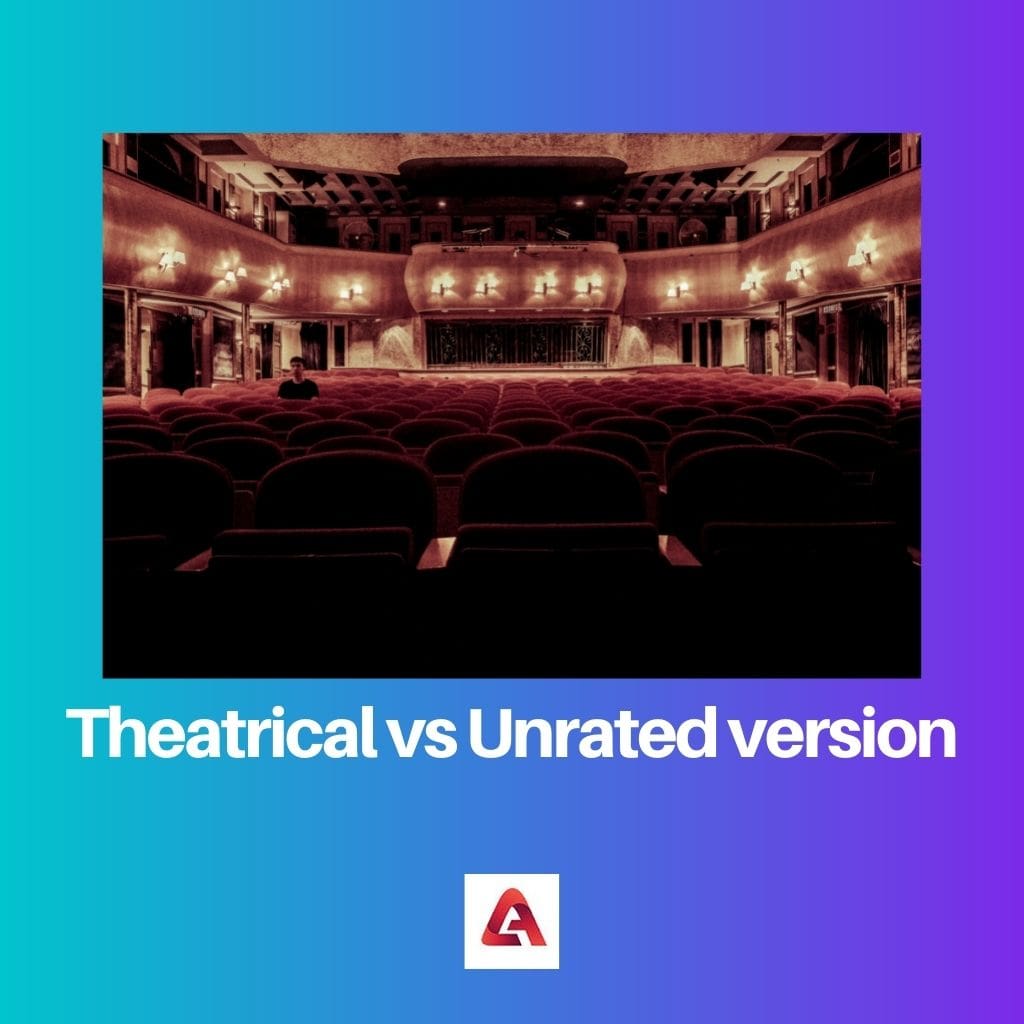The terms theatrical and unrated versions are commonly used in the film industry to describe what kind of movie is being released. The directors or filmmakers send their submissions to the Motion Picture Association of America (MPAA) to decide on a rating.
Key Takeaways
- A theatrical version of a film is the original cut released in theaters, adhering to the guidelines and rating requirements set by the film classification board or organization in a particular country.
- An unrated version of a film is a cut that has yet to be submitted for review by a film classification board and may include additional scenes, extended footage, or content that was deemed unsuitable for the theatrical release.
- The main difference between theatrical and unrated versions lies in their content and target audience, with unrated versions containing more explicit material not included in the version approved for general audiences.
Theatrical vs Unrated Version
The theatrical version of a film is one that has been edited and approved by the Motion Picture Association of America to meet certain guidelines. An unrated version contains more or extended scenes that were not included in the theatrical release and may have more mature or explicit content.

The film’s theatrical version is the final version made by the filmmakers and submitted to be released and viewed in theatres. This version gives a clear view of the scenes the director thought was best for the film.
The unrated version of a film contains any deleted scenes that the filmmakers, for various reasons, did not want to release in theatres. Removing a few scenes might be to maintain the film rating, or maybe the scenes shot were not attractive enough.
Comparison Table
| Parameters of comparison | Theatrical version | Unrated version |
|---|---|---|
| Definition | The film’s theatrical version is the final version made by the filmmakers and submitted to be viewed in theatres. | The unrated version of a film contains added deleted scenes that the filmmakers did not want to release in theatres. |
| Rating | Theatrical versions have a rating given by the MPAA that offers insights into the type of movie displayed. | Unrated versions normally are not submitted to the MPAA for attaining a rating, as they won’t be released in theatres. |
| Censorship | Censorship is done here so that family-friendly movies can be viewed with ease by those who are underage. | Censorship is removed from unrated versions of movies so that audiences can get the complete picture. |
| Reason | They are rated so people can make a safe choice when viewing movies, such as whether it is family-friendly or not. | It is sometimes released for mature audiences, or ugly deleted scenes are added. |
| Examples | Theatrical versions of movies include – All released “Avengers” sequels, “Seven”, all sequels of “Saw”, “Baywatch”, “Salt”, and “the Magic of Belle Isle”. | Unrated versions include – “Saw 2-6: unrated”, “Hatchet”, “Now & Later”, “Salt: unrated”, and “Antares”. |
What is Theatrical Version?
The movies viewed in theatres must be screened beforehand to determine what audiences can see them. A film’s theatrical version is the final version made by the filmmakers and submitted to be released and viewed in theatres.
These final submissions are sent to the Motion Picture Association of America (MPAA) so that a rating can be provided for the movie. The ratings determine the age groups that are eligible to view the film.
Movies are rated so people can make a safe choice when viewing them, such as whether it is family-friendly or not.
The system for rating movies is different in a few countries, but the most common categories are –
- Rated G: General audiences – All ages admitted
- Rated PG: Parental guidance suggested – Some material may not be suitable for children.
- Rated PG-13: Parents strongly cautioned – Some material may be inappropriate for children under 13.
- Rated R: Restricted – Under 17 requires accompanying parent or adult guardian.
- Rated NC-17: Adults Only – No one 17 and under admitted.
All movies showcased in theatres are the “Theatrical versions,” and a few examples are – All released “Avengers” sequels, “Seven”, all sequels of “Saw”, “Baywatch”, “Salt”, “The Magic of Belle Isle”.

What is Unrated Version?
The unrated film version contains deleted scenes that the filmmakers did not want to release in theatres.
Scenes can be deleted from movies for various reasons, such as –
- A few scenes are categorized as the “director’s cut” and removed so the film can be re-released with additional footage.
- At times a few scenes are removed due to being inappropriate for the targeted audience, and the filmmakers wish to maintain the ratings given.
- Some scenes are considered unwanted or unattractive by the director or the filmmakers and are added to the unrated version so the audience can get the complete picture of what they might have missed.
Unrated versions normally are not submitted to the MPAA for attaining a rating, as they won’t be released in theatres. Examples of unrated versions of movies are – “Saw 2-6: unrated”, “Hatchet”, “Now & Later”, “Salt: unrated”, and “Antares”.

Main Differences Between Theatrical and Unrated Versions
- The movie’s theatrical version is the final cut submitted to be viewed in theatres, while the unrated version has a few deleted scenes and is released online or on DVD.
- The theatrical version of a movie has a rating, while the unrated version does not.
- The theatrical version of a movie undergoes heavy censorship, while the unrated versions aren’t checked as thoroughly.
- The reason for censoring the theatrical version is to provide a safe choice for audiences, while the unrated versions are released for mature audiences.
- A few examples of theatrical versions of movies are – “Seven”, all sequels of “Saw”, “Baywatch”, “Salt”, “The Magic of Belle Isle”. Examples of unrated versions – Hatchet”, “Now & Later”, “Salt: unrated”, “Antares”.


The detailed explanation of the MPAA rating system in this post is highly informative, helping audiences understand the implications of different ratings on movie content.
I couldn’t agree more. The breakdown of MPAA ratings and their significance in relation to theatrical and unrated versions is well-presented in this article.
Indeed, understanding the MPAA ratings is vital for moviegoers to make informed choices about the films they watch. This post does a great job of clarifying this aspect.
This article is an invaluable resource for understanding the roles of censorship and content standards in shaping theatrical and unrated versions of films.
I completely agree. The insights provided here shed light on the complex dynamics of content regulation and artistic expression in the film industry.
The discussion of the importance of theatrical versions and the considerations that go into releasing such films is thought-provoking and enriching for film enthusiasts.
Absolutely, this post offers valuable insights into the decision-making processes behind theatrical cuts and how they shape audience experiences.
I found the section on ‘What is Theatrical Version?’ particularly engaging and educational. It’s a well-structured and informative piece.
While I see the importance of understanding these distinctions, I find the proliferation of unrated versions somewhat concerning. This post raises important points for consideration.
I share your concern. The rise of unrated versions may lead to a blurring of content standards and norms in the film industry.
I understand your reservations, but it’s worth noting that the availability of unrated versions also provides creative freedom for filmmakers to explore edgier content.
The distinction between theatrical and unrated versions is crucial for audiences to understand what type of movie they’re watching. This post provides a clear and informative overview of this topic.
I agree, this post does an excellent job of explaining the key differences between theatrical and unrated versions.
I appreciate the in-depth analysis here. It’s important for moviegoers to understand the implications of theatrical and unrated versions for their viewing experience.
Indeed, this article is a valuable resource for film enthusiasts to gain a deeper understanding of theatrical and unrated versions.
Absolutely, this post provides valuable insights into the impact of these different versions on the content and target audience of the film.
The notion of an unrated version allowing for additional creative expression is intriguing. This post presents a compelling analysis of the implications of such versions.
Indeed, the exploration of how unrated versions provide a platform for filmmakers to present unfiltered content is an eye-opening aspect of this article.
The exploration of the implications of unrated versions on audience reception and content standards is thought-provoking and well-articulated in this post.
Absolutely. The discussion on how unrated versions influence audience perceptions and expectations is both enlightening and intellectually stimulating.
A comprehensive and insightful discussion of the differences between theatrical and unrated versions. This article provides clarity on an misunderstood topic.
This post effectively outlines the differences between theatrical and unrated versions, shedding light on the impact of these distinctions on censorship and audience reception.
Absolutely, I found the examples cited in this post particularly enlightening in illustrating the application of theatrical and unrated versions in various movie releases.
Agreed. The comparison table provided here offers a comprehensive breakdown of the nuances between these two versions.